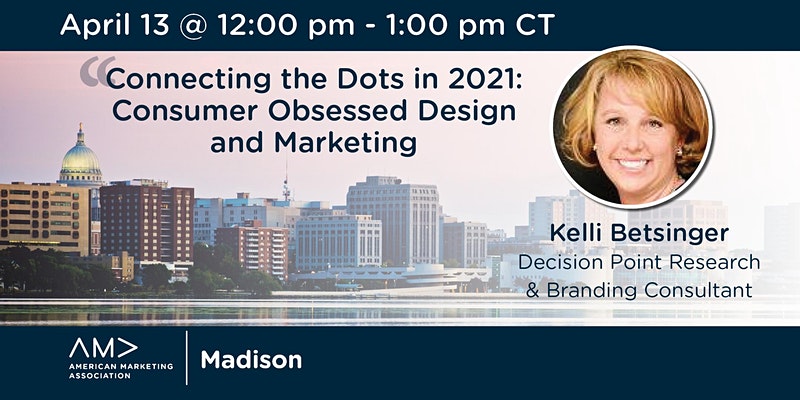The April session of our AMA Madison Signature Speaker Series featured Kelli Betsinger, Research & Branding Consultant for Decision Point, who shared how to use research and behavioral design to drive a more insightful marketing strategy.
Lessons From 2020
As marketers, we already knew that consumer behaviors were changing pre-pandemic, but 2020 brought that trend into sharper focus and showed us that consumer fundamentals are also changing. Kelli shared a few highlights:
At home: Day-to-day habits shifted as people spent more time at home, leading to more sit-down breakfasts, a shift to more indulgent snacks, and a greater awareness of mental health in addition to physical. Athleisure and DIY household projects also trended upward.
In store: Consumers were wary of spending too much time in stores and became more likely to stock up on items as a result.
Online: Due to that wariness about venturing out, online shopping skyrocketed, along with Zoom meetings and working from home. Instacart went from app to essential in a few weeks, and online retailers like Carvana enabled even large purchases to be made online.
Although we don’t know yet if all the pivots and changes of 2020 will become permanent, there’s been lots of talk about the “new normal”. But rather than a “new normal”, it may be that there’s a “new better” – that we can discover by connecting with consumers and learning about what’s important to them.
Are You Consumer Obsessed?
According to Kelli, being “consumer obsessed” helps you to see the entire picture of your clients’ experience. To see if you are consumer obsessed, ask yourself these questions:
- Do you know your brand’s lived experience?
- Do you empathize with your consumer?
- Has your consumer’s view of your product or service changed?
An example of a company doing this well
Kelli circled back to Carvana as an example of a company who is using consumer obsession to their advantage. They’ve redesigned the car-buying process from beginning to end in order to delight their customers – removing the high-pressure salesperson negotiation, allowing the entire experience to be online, and delivering cars directly to the customer’s door or a nearby “car vending machine”. Carvana even flipped the script on a potential negative – the inability to test drive – by offering a seven-day return policy, which their consumers refer to as the “seven-day test drive”. Through all of these innovations, Carvana literally put their consumers in the driver’s seat by placing the process, pace and sense of control in their hands.
Where Do You Start?
Consumer obsession can help you build better relationships with your customers by:
- Identifying moments that matter
- Aligning with user intention, pain points and desires
- Reducing barriers and increasing delight
- Connecting to your customers with empathy, focus and efficiency
As we slowly recover from the pandemic, the current time of transition offers a great opportunity to reevaluate your customer journey. Kelli offered these steps to get started.
Know the lived experience
Observe your audience through Ethnographies and In-Depth Interviews (IDIs). Ethnographies allow your company to see how people interact with your product on a day-to-day basis and how they create workarounds when it doesn’t work as expected. IDIs can be done in-person or online and allow for easier scheduling with consumers and additional buy-in from your internal teams as you can invite more observers.
Map the journey
Your customer journey map is a living, breathing roadmap that needs to be revisited on a regular basis, annually at a minimum. Start by mapping your existing process and use your research to improve and best match your consumers’ preferences. These are some of the key points to focus on:
- Triggers: What sparks the consumer’s intention to purchase?
- Buyer Research Habits: Where are they seeking info and options? Who are their trusted sources?
- Decision-Making Process: Where and what brands are they buying? What is the impact of price?
- Purchase Logistics: Is a salesperson required? Is your product available online? Is there paperwork involved? Are you causing cognitive overload? Can you simplify the process?
- Behavior: Understand what consumers are actually doing, not what they say they are doing.
Create a culture of empathy
Get a real-world view by actually talking to consumers and hearing their voices. Involve your team in the research and share widely throughout your company to get everyone moving in the consumers’ direction.
By learning about the lived experience of your consumers and incorporating research into your marketing strategy, you can identify unique opportunities to make a difference, create an impactful consumer experience, and ultimately drive growth.
See You Online for April’s Craft Marketing Series
AMA Madison invites you to its next virtual event at 4:00 p.m. on April 27, 2021. Andy Crestodina of Orbit Media will present ‘Data-Driven Empathy: 7 Hidden Sources of Your Visitors’ Hopes and Fears’. Andy’s presentation will explore how to consider your audience’s needs as part of your data-driven strategy.
Register here for the online event.

